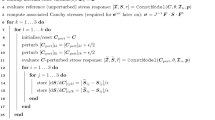Abstract
Gradient-enhanced damage models with constant gradient activity suffer from spurious damage growth at high deformation levels. This issue was resolved by Geers et al. (Comput Methods Appl Mech Eng 160(1–2):133–153, 1998) by expressing the gradient activity parameter as a function of the local equivalent strain at the expense of adding one set of degrees of freedom to those of the standard model. In this contribution, a new formulation of the gradient-enhanced damage model with variable length scale is presented which eliminates the need for the extra set of degrees of freedom. The merits of the proposed formulation are demonstrated, and the choice of the damage evolution law and its impact on the model performance are discussed.
Similar content being viewed by others
References
Bažant ZP (1991) Why continuum damage is nonlocal: micromechanical arguments. J Eng Mech 117: 1070–1087
Bažant ZP (1994) Nonlocal damage theory based on micromechanics of crack interaction. J Eng Mech 120(3): 593–617
Bažant ZP, Jirásek M (2002) Nonlocal integral formulations of plasticity and damage: survey of progress. J Eng Mech 128(11): 1119–1149
Benvenuti E, Borino G, Tralli A (2002) A thermodynamically consistent nonlocal formulation for damaging materials. Eur J Mech A/Solids 21(4): 535–553
Carmeliet J (1999) Optimal estimation of gradient damage parameters from localization phenomena in quasi-brittle materials. Mech Cohesive-Frict Mater 4(1): 1–16
Desmorat R, Gatuingt F (2007) Introduction of an internal time in nonlocal integral theories. Internal report LMT 268, LMT-Cachan, URL http://hal.archives-ouvertes.fr/hal-00200898/en/
Desmorat R, Gatuingt F (2010) Introduction of an internal time in nonlocal integral theories. In: Bićanić N, Borst R, Mang HA, Meschke G (eds) Computational modelling of concrete structures—EURO-C 2010. Taylor & Francis Group, London, Rohrmoos/Schladming, Austria, pp 121–128
Geers MGD, de Borst R, Brekelmans WAM, Peerlings RHJ (1998) Strain-based transient-gradient damage model for failure analyses. Comput Methods Appl Mech Eng 160(1–2): 133–153
Giry C, Dufour F, Mazars J (2011) Stress-based nonlocal damage model. Int J Solids Struct 48(25–26): 3431–3443
Gutiérrez MA (2004) Energy release control for numerical simulations of failure in quasi-brittle solids. Commun Numer Methods Eng 20: 19–29
Iacono C, Sluys LJ, van Mier JGM (2006) Estimation of model parameters in nonlocal damage theories by inverse analysis techniques. Comput Methods Appl Mech Eng 195(52): 7211–7222
Le Bellégo C, Dubé JF, Pijaudier-Cabot G, Gérard B (2003) Calibration of nonlocal damage model from size effect tests. Eur J Mech A/Solids 22(1): 33–46
Mahnken R, Kuhl E (1999) Parameter identification of gradient enhanced damage models with the finite element method. Eur J Mech A/Solids 18: 819–835
Mazars J (1986) A description of micro- and macro-scale damage of concrete structures. Eng Fract Mech 25(5–6): 729–737
Nguyen GD (2011) A damage model with evolving nonlocal interactions. Int J Solids Struct 48(10): 1544–1559
Pamin J, de Borst R (1999) Gradient-enhanced damage and plasticity models for plain and reinforced concrete. In: Wunderlich W (ed) Proceedings of the European conference on computational mechanics—ECCM’99, Technical University of Munich, Munich, pp 482–483, paper no. 636
Peerlings RHJ, de Borst R, Brekelmans WAM, de Vree JHP (1996) Gradient-enhanced damage for quasi-brittle materials. Int J Numer Methods Eng 39(19): 3391–3403
Pijaudier-Cabot G, Bažant ZP (1987) Nonlocal damage theory. J Eng Mech 113: 1512–1533
Pijaudier-Cabot G, Haidar K, Dubé JF (2004) Non-local damage model with evolving internal length. Int J Numer Anal Methods Geomech 28(7-8): 633–652
Simone A, Wells GN, Sluys LJ (2003) From continuous to discontinuous failure in a gradient-enhanced continuum damage model. Comput Methods Appl Mech Eng 192(41–42): 4581–4607
Simone A, Askes H, Sluys LJ (2004) Incorrect initiation and propagation of failure in non-local and gradient-enhanced media. Int J Solids Struct 41(2): 351–363
Voyiadjis GZ, Abu Al-Rub RK (2005) Gradient plasticity theory with a variable length scale parameter. Int J Solids Struct 42(14): 3998–4029
Author information
Authors and Affiliations
Corresponding author
Rights and permissions
About this article
Cite this article
Saroukhani, S., Vafadari, R. & Simone, A. A simplified implementation of a gradient-enhanced damage model with transient length scale effects. Comput Mech 51, 899–909 (2013). https://doi.org/10.1007/s00466-012-0769-8
Received:
Accepted:
Published:
Issue Date:
DOI: https://doi.org/10.1007/s00466-012-0769-8




